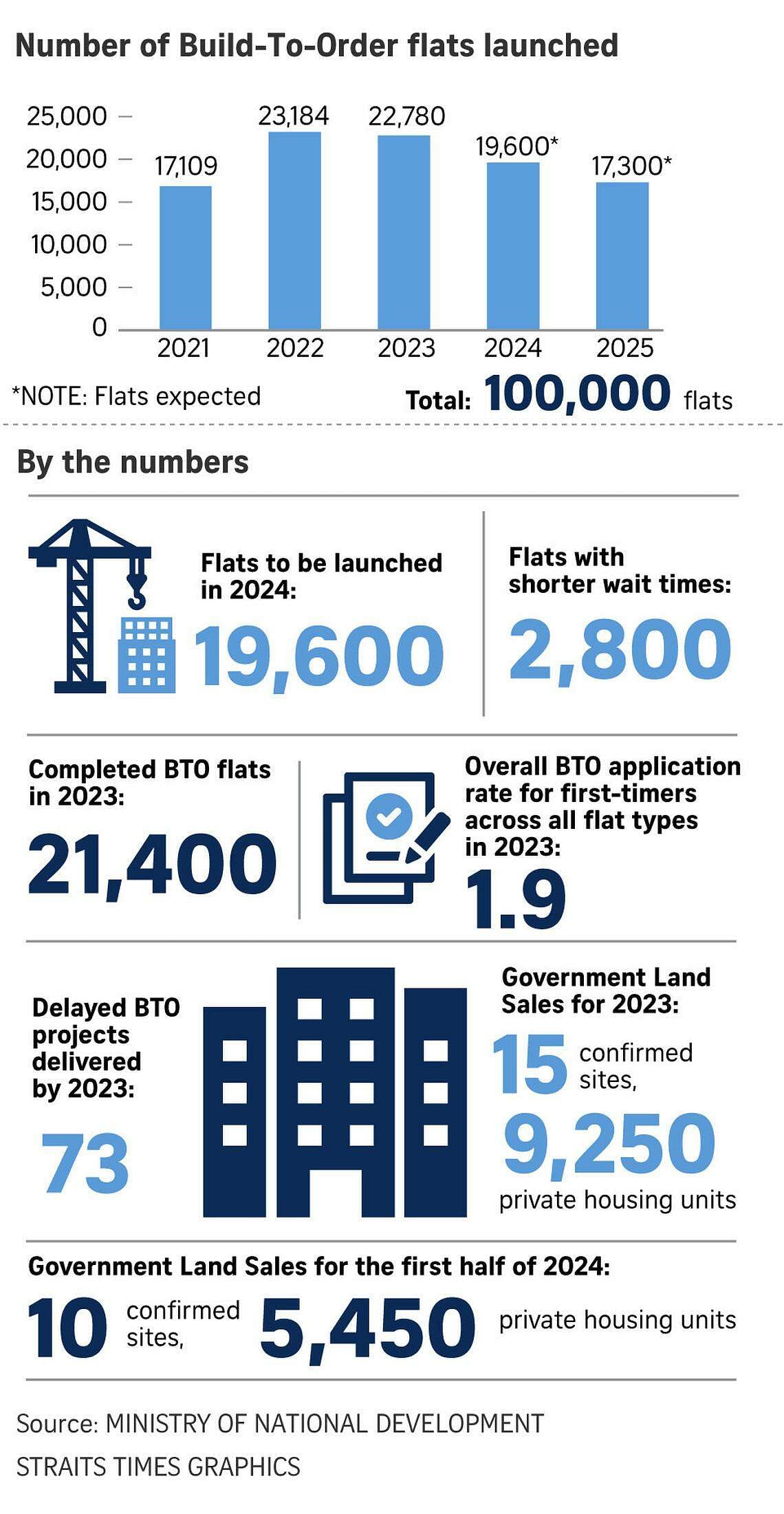SINGAPORE – Some 19,600 Build-To-Order (BTO) flats will be launched in 2024, including 2,800 flats with shorter waits of below three years.
These will be launched across three sales exercises in February, June and October, down from four launches a year, National Development Minister Desmond Lee said in an interview with The Straits Times and Chinese daily Lianhe Zaobao on Dec 28.
The new classification of flats into Prime, Plus or Standard categories will take effect from the October launch, which will also be the largest in 2024, he added.
HDB towns are now categorised as mature or non-mature.
From 2016, BTO launches had typically happened in February, May, August and November. But buyers can expect three launches yearly from 2024.
The Housing Board said in a statement that the Sale of Balance Flats exercise will happen once a year from 2024, with the next round in February.
Such launches previously took place twice yearly – in May and November – but the latter launch in 2023 was pushed to 2024.
About 4,100 flats will go on sale in Bedok, Queenstown, Choa Chu Kang, Hougang, Punggol and Woodlands in the February BTO exercise. Another 1,500 Sale of Balance flats in various towns will be released.
Mr Lee said the number of BTO sale exercises was adjusted to give applicants a wider range of projects in each launch. The larger number of units means they have a higher chance of balloting for a flat.
A wider gap between each launch will also reduce overlaps, where an applicant may have obtained a queue number in one launch but may not have been invited to book a unit when the next launch comes.
“It will not entirely eradicate the overlap because of the sheer number of units, and people come one by one to select a unit... But it will reduce the overlap,” Mr Lee said.
Asked about the drawbacks of having three BTO launches instead of four, Mr Lee said some people might think there are fewer opportunities to apply for a flat.
But he stressed that there was “a lot of overlap” with four launches, and this posed practical problems for applicants. With more launches, there were also fewer units and estates offered per launch, he said.
Noting that overall application rates have stabilised, Mr Lee said: “It is the right time to move from four to three. There are more upsides than downsides.”
The authorities had announced that from the second half of 2024, BTO units in choicer locations will fall under the Prime and Plus categories, which come with stricter resale conditions such as a 10-year minimum occupation period (MOP) and a subsidy clawback.
Standard flats, which will form the bulk of public housing supply, will come with a five-year MOP and have no significant restrictions on the pool of resale buyers.
The reclassification comes amid the authorities’ commitment to launch 100,000 BTO flats from 2021 to 2025.
Mr Lee said: “We’ve launched 63,000 as at the end of 2023, and we are on track to deliver the remaining 37,000 over 2024 and 2025.”
In 2023, 22,780 flats were released for sale. To reach the 100,000-flat goal, about 17,300 flats would have to be rolled out in 2025.
Mr Lee noted that the 19,600 homes that will be launched in 2024 is higher than the pre-pandemic supply of between 16,000 and 17,000 flats a year. HDB said the aim is for three in four new flats launched in 2024 to have waits of four years or less.
The 2,800 flats with shorter waits included in the 2024 BTO supply were initially meant to be launched in 2025, Mr Lee said. Such flats are those already being built when they are launched.

Mr Lee declined to reveal where these flats will be launched in 2024 and said this will be announced at the launch. In 2023, 732 flats with shorter waiting times were offered.
During the Covid-19 pandemic from 2020 to 2022, BTO application rates were high, and it was “not possible” to build flats ahead of launching them as the priority was to ramp up supply to meet demand, he said.
But application rates have stabilised. In 2023, there were 1.9 first-time applicants for each flat, lower than the rate of 3.7 in 2019.
“We were disrupted by Covid-19, and now, we’re going to be back on track to grow this pool of shorter-waiting-time flats.”
Asked how many such flats will be launched from 2025, Mr Lee said about 2,000 to 3,000 can still be expected yearly, though the supply will fluctuate based on demand.
If demand suddenly picks up, Mr Lee said the authorities may have to “push all our chips forward”, which was the approach taken during the pandemic, when shorter-waiting-time flats were “sacrificed” and launched the moment they were built, rather than a year or two later.
Mr Lee said 73, or nearly 80 per cent, of the BTO projects delayed due to the pandemic were delivered by 2023, with the remaining 19 projects to be completed in 2024 and 2025.
HDB said it aims to complete all pandemic-delayed projects by early 2025, barring unforeseen circumstances.
In 2023, HDB completed about 21,400 flats across 23 BTO projects, the highest number of flats and projects completed in the last six years, Mr Lee added.
He was also asked if declining application rates for current Prime Location Public Housing (PLH) model flats were the intended outcome of the scheme, a forerunner of Prime flats.
“Isn’t this good?” Mr Lee replied. “When application rates come down, you see people who are genuinely serious about wanting to live there and build a home there.”
If there are no restrictions, such flats tend to attract people who view them as an investment and intend to sell them for a profit after the MOP, he said.
In the October and December 2023 launches, application rates were muted for PLH flats in mature estates such as Queenstown and Bukit Merah, with nearly all first-time applicants set to get a chance to select a unit.
On the 10-year MOP for PLH flats, Mr Lee said: “That’s the (policy) that makes a lot of difference and distinguishes those who are serious about building a home versus those who may be looking at housing for different reasons... Some people have been very candid with us that they’ve been deterred by that.”
Asked about the expected impact of the new flat classification on the resale market, Mr Lee said: “This is a complex system, and so, no one can be very sure. In any case, the first of these flats will hit the resale market in 15 years.”
The interrelationship between the large number of flats under the existing system and flats to come under the Prime, Plus and Standard model will “not be so straightforward”, Mr Lee said, replying to a question on whether prices of existing resale flats in future Plus areas could rise.
Ultimately, people’s choices are driven by their preferences, needs and budgets, he added.
Commenting on property agents who stoke a “fear of missing out” in buyers of resale flats in what they expect to be future Prime or Plus locations, Mr Lee said in every profession, there will always be some who push the boundaries.
Minister of State for National Development Muhammad Faishal Ibrahim had told a conference by the Singapore Estate Agents Association in November 2023 that the authorities had seen “unhealthy examples” of agents pushing buyers to commit to prices above what they are comfortable with by telling them that prices of flats in certain locations would rise when the new classification kicks in. This, Associate Professor Faishal added, causes irrational decision-making and artificially distorts prices, disadvantaging buyers and affecting the entire resale market.
Mr Lee said: “The Council for Estate Agencies will watch carefully and will take the necessary action against those who fearmonger or do not give the right advice to their clients.”


